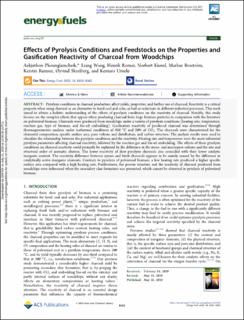| dc.description.abstract | Pyrolysis conditions in charcoal production affect yields, properties, and further use of charcoal. Reactivity is a critical property when using charcoal as an alternative to fossil coal and coke, as fuel or reductant, in different industrial processes. This work aimed to obtain a holistic understanding of the effects of pyrolysis conditions on the reactivity of charcoal. Notably, this study focuses on the complex effects that appear when producing charcoal from large biomass particles in comparison with the literature on pulverized biomass. Charcoals were produced from woodchips under a variety of pyrolysis conditions (heating rate, temperature, reaction gas, type of biomass, and bio-oil embedding). Gasification reactivity of produced charcoal was determined through thermogravimetric analysis under isothermal conditions of 850 °C and 20% of CO2. The charcoals were characterized for the elemental composition, specific surface area, pore volume and distribution, and carbon structure. The analysis results were used to elucidate the relationship between the pyrolysis conditions and the reactivity. Heating rate and temperature were the most influential pyrolysis parameters affecting charcoal reactivity, followed by the reaction gas and bio-oil embedding. The effects of these pyrolysis conditions on charcoal reactivity could primarily be explained by the difference in the meso- and macropore volume and the size and structural order of aromatic clusters. The lower reactivity of slow pyrolysis charcoals also coincided with their lower catalytic inorganic content. The reactivity difference between spruce and birch charcoals appears to be mainly caused by the difference in catalytically active inorganic elements. Contrary to pyrolysis of pulverized biomass, a low heating rate produced a higher specific surface area compared with a high heating rate. Furthermore, the porous structure and the reactivity of charcoal produced from woodchips were influenced when the secondary char formation was promoted, which cannot be observed in pyrolysis of pulverized biomass. | en_US |

